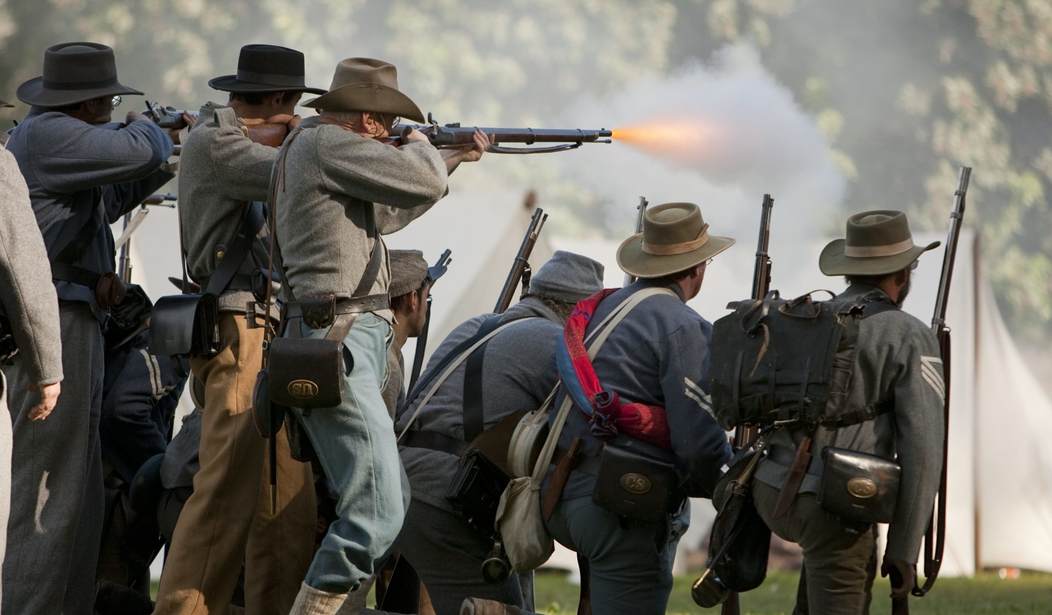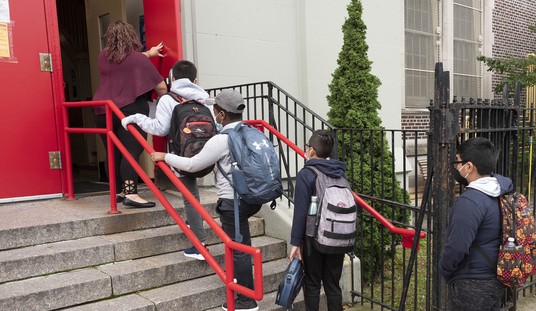I became a Civil War re-enactor in 1982 while taking a course in American military history in college. When we were talking about the Revolutionary War or the Civil War, my professor would show up in his uniform of that era and tell us all about what his equipment and infantry tactics and how he made his own uniform and all kinds of little details that the textbooks overlooked and made history real. I was hooked.
That summer I did my internship at Old Fort Jackson in Savannah, Georgia, and lived the life of a 19th century sailor and artilleryman (I joined the 22nd Battalion Georgia Heavy Artillery). Every day I would teach the kids how to reaf a sail, throw a heaving line, tie all kinds of knots, and finally I would drill kids in how to load and fire a small naval cannon. (The kids just learned the drill; once they were a safe distance away I actually loaded and fired a gunpowder charge. They loved it!)
Pretty soon I was being asked by school teachers to come and teach their kids for an hour about the average life of a Civil War soldier. (The teachers always handled the political/moral issues of slavery, states’ rights, secession, etc. I have been content just to teach about how the average soldier lived, fought, and died.)
Here’s what I’ve learned over the past 34 years:
1. It’s fun to teach!
It didn’t matter if the kids were in the 3rd grade or the 11th grade, all the kids I’ve taught love it when I show up. Their curiosity, their awe, their excitement when I come in all dressed up tells me they are ready to learn. I’ve gone to public and private schools, juvenile detention centers, homeschool co-ops, Boy Scout and Girl Scout meetings … it doesn’t matter.
It’s like somebody in one of those black and white photos just stepped out of the history book. I have never had a bad experience in any school with any age group. I have a story to tell, I have fun telling it, and they have fun with me!
My favorite age group is from about the fifth grade to the seventh grade. They still have that child-like thrill of seeing something new, and they are able to ask good questions. I tell them all about my uniform, pull all sorts of interesting items out of my haversack, and tell stories about them.
They learn what a “housewife” is (it’s a sewing kit), how my toothbrush is made from animal bone and hog’s hair bristles (“oooooh! gross!!”), and how they made hardtack (a big flat cracker) and ate salt pork fried down to mush and mixed with bug-infested flour (yuck!). I also show them my rifled musket, carefully teach them how it was loaded and fired, and give them reasons why the soldiers often fought in ranks standing up.
I show them my original Bible from 1861 and let them know how important this was to the soldiers (no public school has ever censored me for this!). I pull out my bayonet (they usually think it is a sword) and tell them how to use it as a last resort (that always “grosses” them out).
At the end of the class, I usually sing a Northern song (“Battle Cry of Freedom”), a Southern song (“Goober Peas”), and then the favorite hymn of the Civil War (“There Is A Fountain”). We cap it off with all going outside and I shoot off a couple of gunpowder charges up in the air (after clearing it with the school administration and the police, of course). The kids have a blast! (Ha-ha! Sorry, I couldn’t resist.)
Next page: The best way to teach history.
2. Teach history through stories.
When I was in school, my best social studies teachers told fascinating stories about real people. The worst teachers just made us play games or just memorize names and dates. Yes, learning names and dates of key people and events is foundational (and unfortunately there are schools that do not lay this kind of adequate foundation in history), but it is the story that welds the attention of the student to the event.
You gotta know it, and you gotta feel it in every bone of your body. And when you tell the story with passion, the kids will own it. One day, a group of fifth and sixth grade girls came up to me after class and seriously said, “How did you ever survive?” I guess my stories convinced them that I really had stepped out of the history books!
In every one of my “performances” I tell the story of Colonel Joshua Lawrence Chamberlain. I briefly tell them about how he grew up, went off to college to study to become an ordained minister, got married and raised a family, and taught theology and philosophy at Bowdoin College in Maine. Life was good, but then the war came. And this married man with two little children believed his country needed him. The minister of the Gospel trained himself in infantry tactics and eventually became the commander of the 20th Maine.
I walk the kids through his heroic defense of Little Round Top on the second day of the Battle of Gettysburg. I talk about how hot it was that day. How “by accident” one general and his signalman just happened to see a large Confederate force coming through the trees and up the hill. How “by accident” his men were picked to defend that hill and how they got there just minutes before the Confederates did. How Chamberlain was given orders to fight to the death. No retreat. No surrender. Outnumbered and outgunned, they would fight to the death.
By now, I really have their attention. The kids hear about the ferocious gunfire and hand to hand fighting. And how tired both sides were: the men of the 15th Alabama were dying of thirst because their guys with all their canteens had been captured! And now, as the Confederates were coming up the hill for one last charge, Colonel Chamberlain received the worst news: “Colonel, sir, we are out of ammunition.”
That’s when I turn to the kids and ask them, “What should he do? What would YOU do? Go home? Run and hide? Start crying and telling everyone that you’re too tired? Some day it may all come down to just YOU and what YOU will do. What are you going to do?”
Man, at that moment, the kids are all bug-eyed and literally hanging on the edge of their seats. They are now with Chamberlain on Little Round Top. They see the seriousness of the situation, and that moment is priceless.
Then Chamberlain orders his men to launch a bayonet charge (which rarely worked in the Civil War). You can hear a pin drop as I draw my bayonet and fit it to my rifle. Then, I reach for my sword, and scare the kids half to death by yelling “CHARGE!!!!!” just like Jeff Daniels does in this scene from the movie “Gettysburg” (I’m certainly not in the same acting league as Jeff Daniels, but the kids love it every time.)
I tell the rest of his story: how his men drove the Confederates off the hill and saved the Union army that day. He earned the Medal of Honor for his actions, fought on in numerous other battles (he was wounded six times and fought in 24 engagements), received the Confederate surrender at Appomattox, served four terms as governor of Maine, was president of Bowdoin College, and died in 1914.
I end with the declaration: “And the moral of the story is, ladies and gentlemen … never … underestimate … a preacher.” The teachers and kids love it.
Next Page: Why stories like this are important.
3. Kids need real heroes.
Yes, I have watched the string of “Batman” and “Avengers” movies. But I generally yawn through them (my kids make me go with them). Why do I yawn? Because they are not real. Fiction is fine, but reality is better. Kids can learn so much about good character; about perseverance and mercy and sacrifice and honor and devotion and real love — through the heroes of history.
When I was just 10 years old, my sister gave me a book for Christmas: Robert E. Lee: The man and the soldier, a pictorial biography by Philip Van Doren Stern. I read it until the covers fell off (I still have the book).
What a man! You can criticize his decision to fight for the Confederacy all you want; it will never erase his courageous, gentlemanly character. (I am well aware that he was a slave owner. I am also aware that he legally freed all of his slaves before Abraham Lincoln freed even one slave.) Even his enemies admired him! And after the war, he became even greater as an educator and a man dedicated to forgiving, reconciling, and rebuilding. I wanted to be just like him.
Our nation’s history is filled with heroes — all of them flawed, of course, but people we can emulate. Give your kids real flesh and blood heroes.
4. Kids need to learn how good they have it.
When I teach kids about the Civil War, I remind them that life was brutal, nasty, and short. It was not uncommon for a single battle to result in 10,000 casualties. (Gettysburg lasted three days and had over 52,000!). At the Second Battle of Cold Harbor, 8,000 Union soldiers were KILLED (not just wounded) in 30 minutes.
In four years of fighting, approximately 700,000 Americans were killed. I tell students that if you add up all the deaths of ALL of our previous and current wars, it still would not add up to the numbers of Americans who died in the Civil War. It gets pretty quiet when I say that.
They learn how half the soldiers died from disease; Stuff that’s so easily treatable today like diarrhea and dysentery. When I ask them if they know what dysentery is, they all just stare. When I tell them, “It’s bloody diarrhea,” they all shriek in horror. Then I go over what happens when you’re hit with a minié ball or (God forbid) cannister or grape shot.
I tell them how the doctors would amputate a limb, then cauterize the wound with hot tar. The doctors used no face masks; they had no rubber gloves. Infection was rampant. Many soldiers got sick and died just from drinking water that came from wells too close to the latrines (more yuck!).
I don’t overwhelm them with gory detail, but I give them just enough so that they understand a little bit more about the suffering and sacrifice of their ancestors.
5. War is not glorious.
At every step, I try to impress on the kids that war is not glorious. It is not “cool” or “sweet” or “awesome.” General Sherman said it best: “War is cruelty, and you cannot refine it.” But sometimes, ya gotta fight. Some things are worth fighting for. And dying for.
My hope is when I am finished, they are just a little bit more appreciative of what they have as Americans. And thankful for those who gave it to them.










Join the conversation as a VIP Member